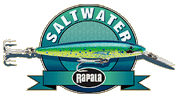

Antti had fished his whole life and there was no better place than Karelia to fish. The Finns are among the world's oldest fishing people and it is firmly in their blood. The oldest fishing net, about 8,000 years old, was found in Antrea, Karelia. Having lost his home in Karelia, after the Soviet invasion of 1944 in which 10% of Finland was lost, Antti brought his family to Canada. In Long Lake Ontario near Sudbury, he became famous for his fishing skills using patented lures of his own design which he manufactured and sold. Nobody caught fish that big in the lake for years. The photo was taken in his front yard in the 1950's. The sauna is in the background, the lake on the right and Suomi Ranta boat launch and beach is a fifty meters behind Antti, and the Finnish hall is right across the road. In the summer Antti used a rowboat, but in the winter, he used various kinds of jigs. I fished for small-mouthed bass from our pier.
The lure Antti developed was a "secret alloy" of which the writer only knows several constituants. He used babit, brass and possibly lead. The molten mixture was poured into a multicavity mold. When it had cooled, they were taken out of the mold and the rough edges were removed, filed, wire-brushed, sanded and burnished to a high gloss. The ends had depressions for drilling - the holes thus made were used to fasten the hardware.
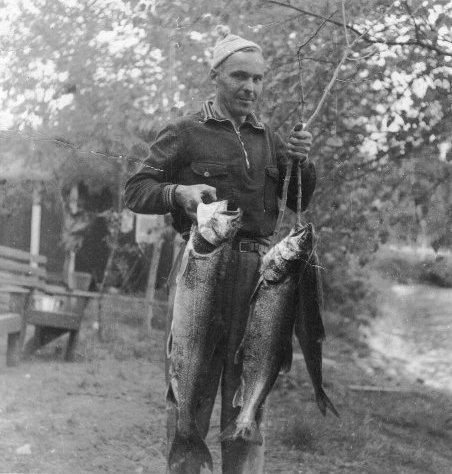
Work in the Sudbury nickel mines was not his idea of why he came to Canada. Two years of sneezing and coughing in the bad air was enough. He moved his family to Vancouver B.C. where there is plenty of fresh air. Antti made lures all the way across Canada in the campgrounds, catching big fish and selling lots of lures. Paying our own fare was the name of the game. Self-sufficiency, ingenuity, survival. The Finns did not use the system asking for nothing but work. The money from the lures bought the gas and fed the family. Two years after longshoring in Vancouver, the family settled in Victoria B.C. and Antti took menial work but a few years later became a salmon fisherman, with Sointula as base. His war injuries to his legs forced him to retire from fishing after only 3 years. He changed careers and became a gifted massage (physio) therapist. He was better than a physiotherapist. He had an uncanny way of knowing where the problem originated and what to do about it, that made his work legendary in two western provinces in Canada.
Fishing at Victoria
The family was now living in the ultra-British capital of British Columbia. Some say Victoria is more British than England, but that is just for the tourists. The Empress Hotel and the Parliament Buildings are the focal points of the inner harbor, and the area is saturated with hotels, restaurants, tea-houses and pubs. It is a favorite destination for Seattle residents and world travellers alike. The tourist season stops abruptly in the first week of September.
The author as a boy spent most of his time down at the waterfront of Victoria. The breakwater was a favorite spot to fish. We used all kinds of bait: lures, worms, even white rags. When we made friends with some recent immigrants from Finland, my brother and I showed them how to fish. "We use white rags after sunset," we told our new friends. The kelp beds often took the hooks and lines, but we did catch fish. They were amazed you could catch fish with such a bait. So here we were, growing up in a country which was just as big on fishing as our home country of Finland, except the fish were often bigger. My fishing ended one day when I found a parasitic worm in the fish, just as I was about to cook it. I would never forget it, and related it to the raw sewage outfall at the Victoria waterfront. They never did install a treatment plant there, they merely extended the pipe. The University sent down water samplers and reported everything was fine! But the scientists were wrong - even a kid could tell what was going on there. We knew about all the illnesses we got because we played there all the time. My mistrust of "official science" was just beginning.
Vancouver Islanders were just as turned towards the water as we were, boating being a very big part of just about everyone's lives. It seems that everyone has some kind of sailboat, yacht, motorboat, skiff, or rubber raft - or knows someone who does. Many earn their living from the sea in one way or another. So it is not unusual that the author was in the Canadian Coast Guard at some point, since Victoria is not known for its job opportunities.
The main catch around these parts: Pacific Salmon; Ling Cod, Rock Cod and Sea Bass around the rocky shores and kelp beds. Salmon swim in schools and it was not easy to catch them from the shore. But you could catch them as they swam close to the end of the breakwater if you were lucky. Otherwise you needed a boat. Antti bought a 30 ft. gillnetter and began fishing from the Finnish settlement of Sointula. The fridge was never without at least enough salt salmon to last until the following spring.
Commercial Salmon Fishing
Many nationalities are represented in the fishing industry on the
coast. Natives, Canadians of British descent, Finns, Japanese, Norwegians,
Swedes, and various other immigrant people took to the sea for a living. It
was fun to see all the activity down at fisherman's warf in Victoria in the
springtime. You sensed that the men really enjoyed their work. Some were
obviously more successful than others. The trollers especially. The troller
fishermen did not like the purse seiners, or maybe it was envy, which took so many fish at one time. Most of the men trolled the west coast of Vancouver Island, from such
places as Tofino and Ucluelet. Commercial fishing was a real opportunity up
until the last decades of the 1900s. Overfishing and mismanagement of the
resource put an end to this, and today hundreds of licenses are bought back
by the Federal Government yearly. (about 600 in 1999) Today there is a
serious crisis in the industry and there are many sites on the Internet
about it. There has been some rebound in this resource lately due to fewer fishermen. When I saw what was going on there, I remembered the
"official science" of earlier years. Why was I not surprised that the
government was allowing this resource to die? The blame has to go on the Federal Government, the same one that let the eastcoast fishing industry die.
In the good times, you could fish in the summer, and collect unemployment in the winter - an ideal situation. What kind of life could give you that! The top student at the University of Victoria in the year the writer graduated was the son of a Finnish fisherman. (Laukkanen) Do you know what he chose as a career? Not physics, but Fishing. Many were smart enough to capitalize on this situation by building houses, apartments, boats, and so forth in the winter months. Some became millionaires many times over, that I knew personally. A few chose to sit in the beer parlors, or go down to their boats and drink. The smart ones just had a little snort after supper, or stayed away from it altogether.
The Finns often fished in groups, and were very successful. Since they spoke Finnish on the radio, it was impossible for anyone else to know what they were saying - it was all about the location of fish. There are four main areas that Finns used as bases of operation on the British Columbia Westcoast: Steveston - near Vancouver, Victoria, Sooke, in the south; Sointula, Tofino, and Ucluelet, in the north - depending on which side of Vancouver Island they are fishing. Natives fished out of their own ports, such as Bella Coola, Alert Bay, and so forth. The Westcoast fishermen were mainly trollers, while the inlets and the inside passage between Vancouver Island and the mainland was used by both gillnet fishermen and trollers.
 Antista tuli Tyynenvaltameren kalastaja, ja
Sointula, joka sijaitsee Vancouverin Saaren koillisella puolella Malcolm
Saarella, josta hän kalasti, oli hänen kotinsa kesällä. Siima kalastajat
kalastivat yleensä eniten Vancouverin Saaren länsirannikolla, ja verkko
kalastajat enemmän Vancouverin Saaren ja mantereen välisissä vesistöissä.
Monet kalastajat tulivat hyvin toimeen kalastuksellaansa kun vain kalan
hinnat pysyivät korkealla ja pystyi rakentamaan taloja myytäväksi talvella,
tai mitä tahansa, ja kalastaa kesät, niitä suuria länsirannikon lohia. Ja
heillä vasta vehkeet oli - hienot suuret veneet joilla pystyi menemään pari
sataa kilometriä maasta merelle, vaikka Queen Charlotte Island:iin saakka.
Monet kalasteli pohjakalaa kun lohi aika meni umpeen. Olin itse Charlottilla
töissä kun illalla menin kävelylle kalastusvene rantaan. Kuulin sieltä
tuttua ääntä - suomen kieltä. Kävelin lähemmälle ja huomasin että se oli
isän kalastaja kaveri, Hautakosken Veikko ja pari toista Suomalaista. Juttua
riitti se on selvä.
Antista tuli Tyynenvaltameren kalastaja, ja
Sointula, joka sijaitsee Vancouverin Saaren koillisella puolella Malcolm
Saarella, josta hän kalasti, oli hänen kotinsa kesällä. Siima kalastajat
kalastivat yleensä eniten Vancouverin Saaren länsirannikolla, ja verkko
kalastajat enemmän Vancouverin Saaren ja mantereen välisissä vesistöissä.
Monet kalastajat tulivat hyvin toimeen kalastuksellaansa kun vain kalan
hinnat pysyivät korkealla ja pystyi rakentamaan taloja myytäväksi talvella,
tai mitä tahansa, ja kalastaa kesät, niitä suuria länsirannikon lohia. Ja
heillä vasta vehkeet oli - hienot suuret veneet joilla pystyi menemään pari
sataa kilometriä maasta merelle, vaikka Queen Charlotte Island:iin saakka.
Monet kalasteli pohjakalaa kun lohi aika meni umpeen. Olin itse Charlottilla
töissä kun illalla menin kävelylle kalastusvene rantaan. Kuulin sieltä
tuttua ääntä - suomen kieltä. Kävelin lähemmälle ja huomasin että se oli
isän kalastaja kaveri, Hautakosken Veikko ja pari toista Suomalaista. Juttua
riitti se on selvä.
Muuten, Vancouverin Saaren ja Charlottin välivesi voi tulla yhtäkkiää vaaralliseksi jos sattuu tulla myrsky. Moni kalamies on kalastanut viimiset kalat justiin niissä vesissä. Siksi säähavanto on tärkeätä kalamiehelle. No riittää kala tarinaa vähäksi ajaksi.
Reference Books on Fishing
 Gadgets
Talk to Me Walkie-Talkie
Gadgets
Talk to Me Walkie-Talkie
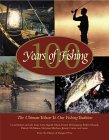 100 Years
of Fishing by Michael Dregni (Editor),
100 Years
of Fishing by Michael Dregni (Editor),
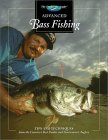 Advanced
Bass Fishing (The Hunting & Fishing Library)
Advanced
Bass Fishing (The Hunting & Fishing Library)
 Brook
Trout by Nick Karas
Brook
Trout by Nick Karas
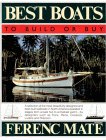 Best Boats
to Build or Buy
Best Boats
to Build or Buy
© 2000 - 2006 Osmo Joronen